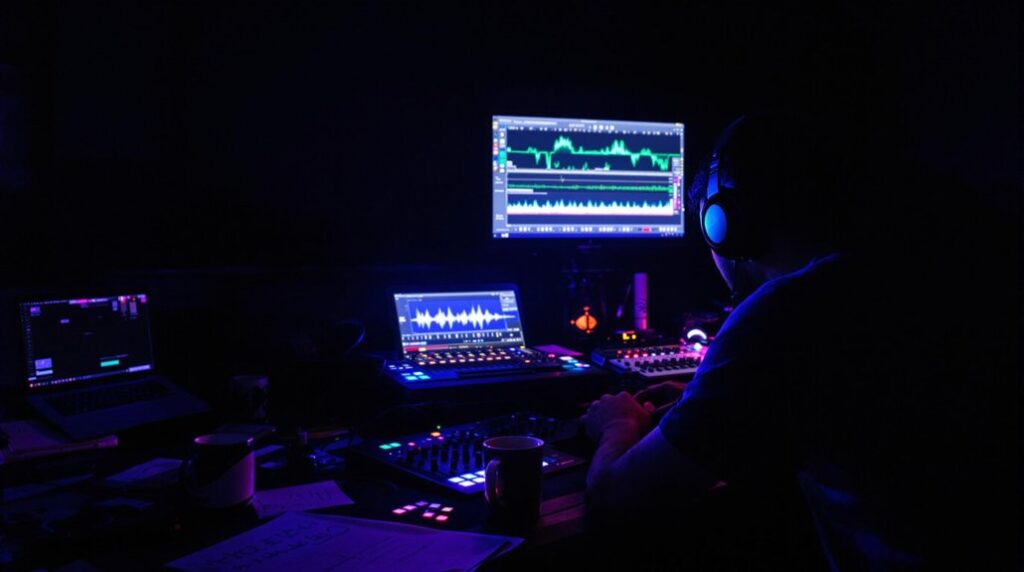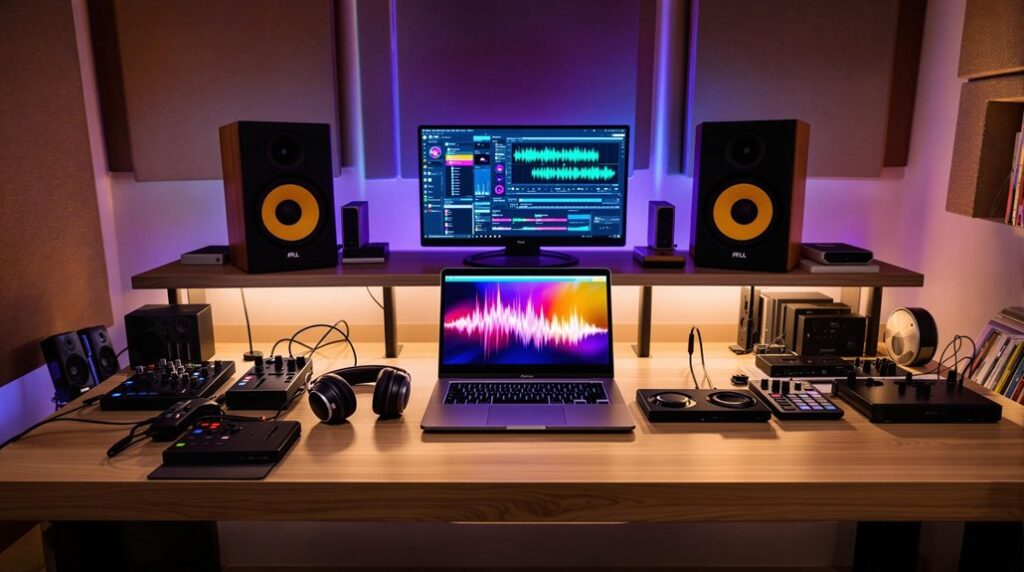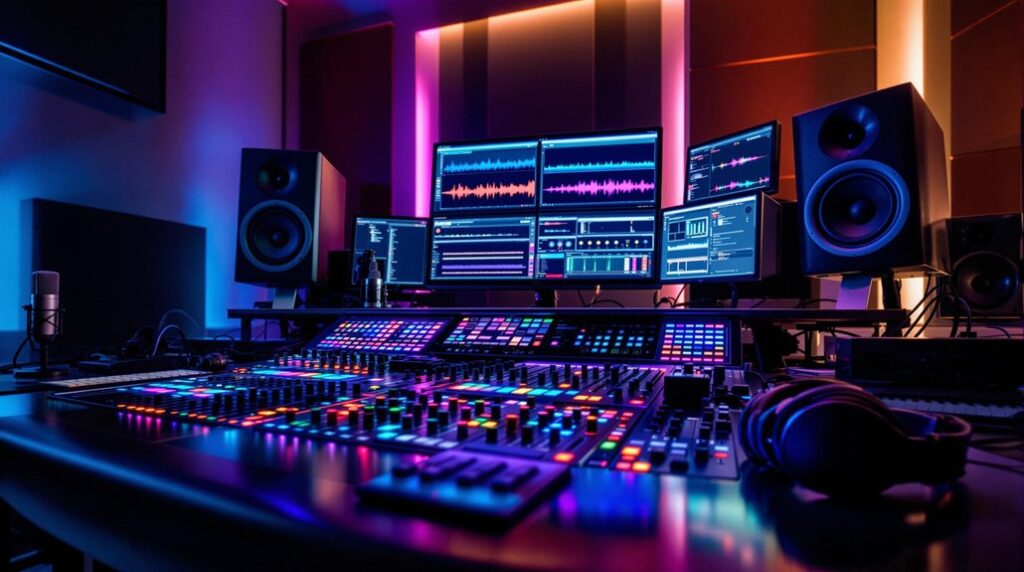To achieve professional-quality audio mixing, make sure you have essential hardware. Start with a high-quality audio interface, like those from Universal Audio, featuring superior preamps and AD/DA converters. Opt for studio monitors such as Yamaha HS Series for true sound reproduction. Use closed-back headphones like Beyerdynamic DT 770 Pro for accurate monitoring. Your mixing desk should include motorized faders and built-in signal processing. Treat your room with bass traps and acoustic panels to optimize acoustics. Additionally, reliable XLR cables and proper cable management are essential. For an in-depth exploration of each component and how to maximize your setup, continue ahead.
Key Takeaways
- Audio Interface: Choose one with high-quality mic preamps and AD/DA converters for accurate analog-to-digital signal conversion.
- Studio Monitors: Invest in accurate models like Yamaha HS Series for precise sound reproduction.
- Headphones: Select high-impedance, closed-back headphones like Beyerdynamic DT 770 Pro for detailed monitoring.
- Mixing Desk: Opt for desks with motorized faders, EQ, and dynamics processing for efficient mixing.
- Acoustic Treatment: Use bass traps and diffusers to optimize room acoustics and sound quality.
Audio Interface
When setting up your professional audio mixing studio, an audio interface is essential for converting analog signals to digital and facilitating seamless communication between your equipment and computer. Selecting the right audio interface requires careful consideration of several factors. You’ll need to evaluate the number of inputs and outputs you require, ensuring it can handle your recording needs efficiently.
Key features to prioritize include high-quality mic preamps, reliable AD/DA converters, and robust connectivity options such as USB or Thunderbolt.
Best practices for audio interface selection involve choosing reputable brands like Universal Audio, Focusrite, and Audient, known for their professional-grade sound and reliability. These brands offer interfaces with excellent build quality and superior audio fidelity, essential for high-quality recordings and playback.
Troubleshooting common issues with audio interfaces typically involves checking cable connections, ensuring driver software is up-to-date, and verifying compatibility with your Digital Audio Workstation (DAW). Addressing latency problems can often be resolved by adjusting buffer settings within your DAW.
Regular firmware updates from the manufacturer can also help maintain peak performance and resolve potential software conflicts, ensuring your studio runs smoothly and efficiently.
Studio Monitors
Selecting the right studio monitors is crucial for achieving accurate sound reproduction and making informed mixing decisions. You need monitors like the Yamaha HS Series or KRK Rokit, known for their precise sound accuracy, to guarantee every detail in your mix is audible.
However, simply owning high-quality monitors isn’t sufficient; speaker placement and room acoustics critically impact performance. Proper speaker placement involves positioning your monitors at ear level and forming an equilateral triangle with your listening position. This setup helps achieve a balanced stereo image and minimizes phase issues.
Room acoustics play an important role, too. Untreated rooms can introduce unwanted reflections and standing waves, distorting your perception of the mix. Acoustic treatment like bass traps and diffusers can help mitigate these issues.
Monitor calibration is another crucial step. Calibration ensures that your monitors deliver consistent sound levels and frequency responses, allowing for precise mixing. Tools like SPL meters and calibration software can assist in this process.
Investing in studio monitor stands will further optimize sound dispersion and reduce vibrations, contributing to a more accurate listening environment. In professional audio mixing, these considerations are essential for achieving the best possible results.
Headphones
In professional audio mixing, selecting the appropriate headphones—whether closed-back for isolation or open-back for a natural soundstage—is essential for accurate monitoring and critical listening. Closed-back headphones like the Beyerdynamic DT 770 Pro offer excellent isolation, making them ideal for environments where external noise could be a distraction. They allow you to focus on the sound signature of your mix without interference. On the other hand, open-back headphones such as the Sennheiser HD 650 provide a more natural soundstage and are preferred for critical listening, giving a true representation of how your mix will sound in a natural environment.
Headphone comfort is vital for long mixing sessions. High impedance models like the Audio-Technica ATH-M50x deliver detailed audio reproduction, essential for detecting subtle nuances in your mix. However, avoid wireless Bluetooth headphones for mixing, as they can introduce latency issues that impede precise audio tasks.
Here’s a quick comparison:
| Model | Type | Key Features |
|---|---|---|
| Beyerdynamic DT 770 Pro | Closed-back | Excellent isolation, durable |
| Sennheiser HD 650 | Open-back | Natural soundstage, comfortable |
| Audio-Technica ATH-M50x | High impedance | Detailed audio, portable |
| Wireless Bluetooth Options | N/A | Potential latency, not recommended |
Ensuring your headphones are comfortable, durable, and capable of accurate sound reproduction will greatly enhance your mixing precision and overall experience.
Mixing Desk
When selecting a mixing desk, you’ll want to take into account key features like motorized faders and built-in signal processing, which enhance your mixing capabilities.
Make sure it offers robust connectivity options for seamless integration with your existing equipment.
Pay attention to the user interface design, as an intuitive layout can greatly improve your workflow efficiency.
Key Features Overview
A mixing desk’s key features, such as channel strips with EQ and dynamics processing, motorized faders, and extensive routing capabilities, are essential for professional audio mixing. When selecting a mixing desk, understanding the channel strip functionalities and fader control options is vital for achieving excellent sound quality and workflow efficiency.
Channel strips are the heart of your mixing desk, providing individual control over each audio input. They typically include EQ settings for frequency balancing, dynamics processing like compressors and gates for sound shaping, and auxiliary sends for effects routing. Mastery of these elements allows you to fine-tune each track to fit perfectly within the mix.
Motorized faders offer precise, automated control over volume levels, enabling you to make detailed adjustments and recall settings quickly. This feature is particularly beneficial during complex mixing sessions where consistency and accuracy are paramount.
Extensive routing capabilities ensure that audio signals can be directed to various destinations within your setup, enhancing flexibility and creativity.
Key features to bear in mind:
- Channel strip functionalities: EQ, dynamics processing, and auxiliary sends.
- Fader control options: Motorized faders for precise automation.
- Built-in digital effects: Streamline workflow with integrated effects.
- Bus grouping: Efficiently manage multiple tracks with grouped controls.
These features collectively form the backbone of any professional mixing desk, offering the tools you need to create high-quality audio productions.
Connectivity and Integration
Your mixing desk‘s connectivity and integration capabilities are essential for seamlessly routing audio signals and integrating outboard gear to achieve professional-grade sound. Effective signal routing guarantees that each audio signal flows through the desired path, allowing you to apply precise processing and effects.
Hardware compatibility plays a vital role in making sure your mixing desk can interface with various outboard gear like compressors, EQs, and reverb units.
To achieve a streamlined signal flow, it’s critical to understand your mixing desk’s input and output configurations. Analog desks often offer direct tactile control, facilitating quick adjustments to your signal path. However, digital mixing desks excel in providing extensive routing options, recall capabilities, and automation, which can greatly enhance your workflow efficiency.
Outboard gear integration is another pivotal aspect. By properly connecting your compressors, EQs, and other external processors, you can sculpt and refine your sound to meet professional standards. Ensure that your mixing desk has sufficient insert points, auxiliary sends, and returns to accommodate all your external hardware.
This level of integration allows for greater flexibility and creative control, ensuring that your mixes aren’t just technically sound but also artistically expressive.
User Interface Design
Understanding the user interface design of a mixing desk is essential for mastering its functionality and optimizing your workflow. A well-designed interface includes fader controls, knobs, buttons, and touchscreens, all vital for precise user interaction.
Whether you’re working in a compact home studio or a large professional setup, the graphic layout of your mixing desk can greatly impact your efficiency.
Modern mixing desks come with digital features like automation, recall settings, and customizable layouts, allowing for a tailored user experience. These elements enable you to easily navigate and control multiple tracks and parameters, ensuring a smooth and efficient mixing process.
Ergonomic design considerations are critical, especially when you’re working long hours. A mixing desk that prioritizes comfort and accessibility will help maintain your productivity and prevent fatigue.
- Fader Controls: Essential for adjusting audio levels with precision.
- Knobs and Buttons: Allow for fine-tuning effects and other parameters.
- Touchscreens: Offer an intuitive way to interact with various functions.
- Customizable Layouts: Enable a personalized setup that suits your workflow.
Acoustic Treatment
To optimize your mixing environment, focus on room sound isolation, diffusion, and absorption panels.
Proper placement of bass traps is imperative for controlling low-frequency energy and enhancing clarity.
Effective acoustic treatment will guarantee accurate monitoring for precise audio mixing decisions.
Room Sound Isolation
Effective room sound isolation in a professional audio mixing studio relies on strategically placing bass traps, diffusers, and acoustic panels to control reflections and standing waves. By employing soundproofing techniques, you can guarantee that your room acoustics are optimized for accurate monitoring and mixing.
Bass traps are essential for absorbing low-frequency sound waves, which are notorious for causing muddiness and imbalances in your mix. Placing these in corners where bass build-up is most prevalent can greatly improve your room’s response.
Isolation booths are another essential component, providing noise reduction and allowing you to capture clean recordings without external interruptions. Acoustic panels play a critical role by taming mid and high-frequency reflections, ensuring that your mixes are clear and precise.
To summarize essential elements for effective room sound isolation:
- Bass traps: Absorb low-frequency waves, reducing muddiness.
- Isolation booths: Provide noise reduction and clean recordings.
- Acoustic panels: Tame mid and high-frequency reflections.
- Soundproofing techniques: Optimize room acoustics for accurate monitoring.
Diffusion and Absorption Panels
Combining both diffusion and absorption panels into your mixing studio’s acoustic treatment guarantees a balanced and controlled audio environment.
Diffusion panels scatter sound waves, reducing echoes and enhancing acoustic clarity, thereby contributing greatly to sound enhancement. By breaking up direct sound reflections, diffusion panels create a more natural and spacious sound, which is essential for precise audio monitoring.
Absorption panels, on the other hand, absorb excess sound energy, minimizing reflections and preventing low-frequency buildup. This absorption is vital for creating a more controlled audio environment, allowing you to hear a true representation of your mix. Proper placement of these panels is key to achieving excellent acoustic enhancement.
Generally, diffusion panels are placed on the rear walls to handle scattered reflections, while absorption panels are positioned on the side walls and ceiling to tackle first reflections and low-frequency issues.
Incorporating these panels strategically will greatly improve sound quality and balance in your mixing room. By optimizing your studio acoustics with diffusion and absorption panels, you guarantee that your audio mixing process is both accurate and effective, making your final product the best it can be.
Bass Trap Placement
Having established the importance of diffusion and absorption panels, let’s now focus on the critical role of bass trap placement in refining your studio’s acoustic treatment. Bass traps are essential for absorbing low-frequency sound waves, which helps to reduce room resonance and improve audio clarity. Proper placement is key to maximizing their effectiveness.
To effectively manage low-end frequencies and control bass buildup, consider the following placement strategies:
- Trihedral Corners: Place bass traps in the trihedral (three-surface) corners where two walls and the ceiling or floor meet. This is where low-end frequencies tend to accumulate the most.
- Wall-Wall Intersections: Install bass traps at wall-wall intersections to target areas of high room resonance and standing waves.
- Behind Monitors: Position bass traps directly behind your studio monitors to absorb the rear reflections from the speakers, thereby enhancing accuracy in your monitoring.
- Symmetry: Ensure symmetrical placement of bass traps to maintain a balanced sound environment, which is critical for precise audio mixing.
Microphones
Understanding the diverse types of microphones, including condenser, dynamic, and ribbon, is essential for achieving professional audio mixing results. Your microphone selection will greatly impact the sound quality and characteristics of your recordings. Condenser microphones, known for their sensitivity and wide frequency response, are ideal for capturing vocals and acoustic instruments. Dynamic microphones, being robust and less sensitive to high sound pressure levels, excel in live settings and with louder instruments like drums. Ribbon microphones, offering a natural and smooth sound, are perfect for high-fidelity recordings.
Proper recording techniques, such as precise placement and angle, are vital. Consider the microphone’s polar pattern—cardioid, omnidirectional, or figure-8—as it affects sound pickup direction and sensitivity.
| Microphone Type | Best Use Case |
|---|---|
| Condenser | Vocals, acoustic instruments |
| Dynamic | Live settings, drums |
| Ribbon | High-fidelity recordings |
Regular microphone maintenance ensures longevity. Clean your microphones periodically and store them in protective cases. Troubleshooting tips include checking cables and connections for faults and ensuring proper phantom power for condenser mics.
Understanding these aspects of microphones will enhance your audio mixing capabilities, resulting in professional and polished recordings.
MIDI Controllers
In today’s music production landscape, MIDI controllers are essential tools that empower you to input, control, and manipulate musical elements with precision and ease. These versatile devices come in various sizes and configurations, including keyboard-style, pad-based, and knob-based controllers, each offering unique advantages to cater to your specific workflow needs.
MIDI controllers greatly enhance your workflow by providing tactile control over virtual instruments and effects within your digital audio workstation (DAW). With features like faders, drum pads, and assignable knobs, they offer unmatched flexibility for music creation. MIDI controller customization allows you to tailor the device’s interface to your personal preferences, boosting performance and creativity.
Seamless integration with popular DAWs like Ableton Live, Logic Pro, and FL Studio ensures that MIDI controllers remain versatile and indispensable tools for any producer or musician. It’s important to take into account MIDI controller software compatibility and keep your device updated to leverage the latest advancements and improvements.
Here are some key features to look for in a MIDI controller:
- Assignable knobs and faders for real-time control
- Velocity-sensitive drum pads for dynamic beat-making
- Seamless integration with popular DAWs
- Customizable layouts for personalized workflow
Cables and Accessories
High-quality cables and accessories are essential for guaranteeing pristine audio transmission and maintaining a professional mixing environment. You need to invest in quality XLR cables, as they’re critical for reliable audio signal transfer.
Balanced cables are particularly effective at noise reduction, minimizing interference and ensuring clean, accurate audio transmission during mixing sessions.
Maintaining signal integrity is paramount, and proper cable organization plays a pivotal role. A clutter-free workspace not only enhances your workflow but also helps avoid potential signal degradation caused by tangled or improperly placed cables. Use cable ties and racks to keep everything organized.
For equipment compatibility, it’s important to choose cables that match the specifications of your gear. This ensures that your connections are secure and that the audio signal is transmitted without loss.
Accessories like pop filters and shock mounts also contribute to high recording quality by reducing unwanted noise and vibrations, further enhancing the clarity of your mixes.
Investing in high-quality cables and accessories has a significant impact on the overall sound quality and user experience in professional audio mixing. By prioritizing these elements, you guarantee top-notch performance and longevity of your mixing setup.
Frequently Asked Questions
What Are the Essential Tools for Mixing?
You need a mixing desk and high-quality studio monitors for accurate sound representation. Make sure you use compression units like LA2A, 1176, and EQs like 1073. These tools shape your mix’s quality and character effectively.
What Equipment Do You Need to Mix and Master?
You’ll need studio monitors for accurate sound, acoustic treatment for a balanced environment, quality preamps, AD/DA interfaces, and compressors like the LA2A and 1176. These elements guarantee precise audio mixing and mastering.
How Do I Make My Mix Sound Professional?
To make your mix sound professional, optimize room acoustics and use reference tracks. Guarantee your monitoring environment is accurate. Compare your mix to professional tracks to maintain balance, EQ, and dynamics consistency.
Do You Need a DAC for Mixing?
You don’t need a DAC for mixing since many audio interfaces have built-in signal conversion. However, using a high-quality DAC can enhance audio clarity by reducing noise and distortion, ensuring more accurate and detailed playback.
Conclusion
To achieve high-quality professional audio mixing, you’ll need essential hardware like:
- an audio interface
- studio monitors
- high-quality headphones
- a reliable mixing desk
- proper acoustic treatment
Don’t forget versatile microphones, responsive MIDI controllers, and durable cables and accessories. With the right gear, you can guarantee your mixes are clear, balanced, and polished.
Invest wisely in these tools, and you’ll greatly enhance the quality of your audio productions.




